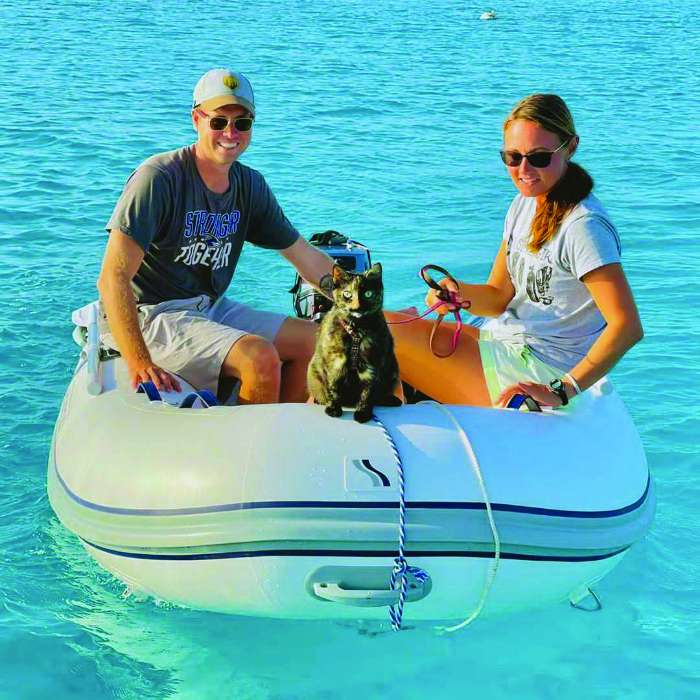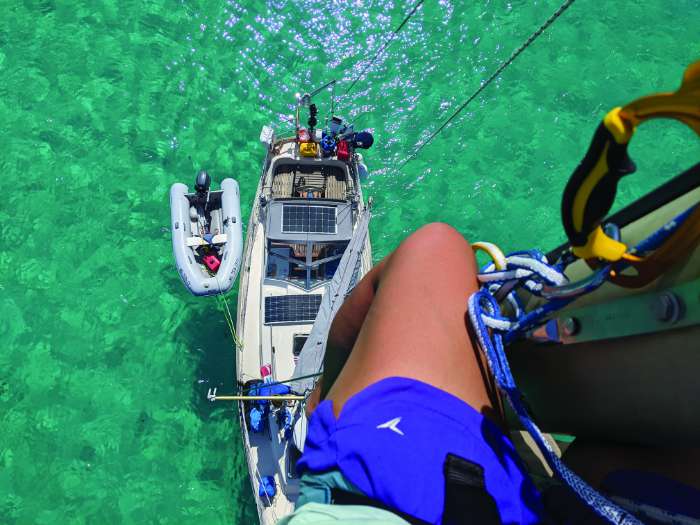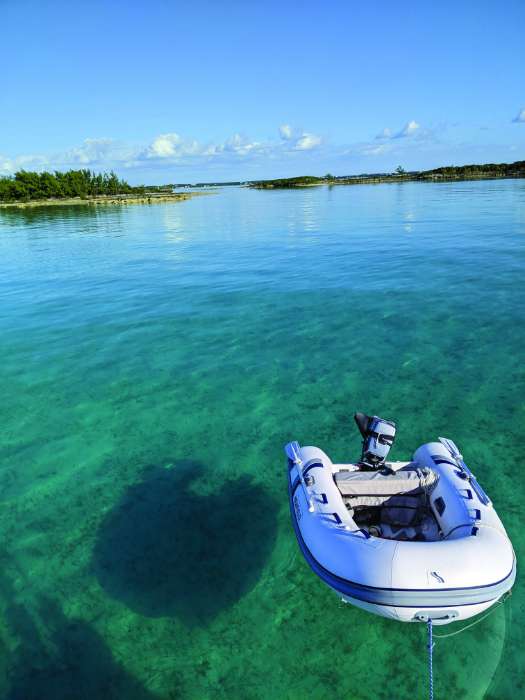Want To Keep Your Dinghy in Place While You Cruise? Try These Five Tips.
One year ago we were invited over for dinner to a cruising friend’s boat while anchored in between Little Ragged Island and Ragged Island in the Bahamas. A friend grabbed the dinghy painter when we approached and quickly tied our short polypropylene painter to the boat’s stern cleat. Missy and I handed our drinks and appetizer to helpful hands on deck. I left the dinghy’s backup painter unused and on the dinghy floor. We sat down, cracked open a Sand’s beer, and enjoyed a night of Mexican train dominoes and a light meal.

It was well past cruiser’s midnight and nearly 10 p.m. when we decided to head back to Ukiyo. My stomach dropped when I didn’t see our dinghy. For potentially the past three or four hours it had been drifting away, off to Cuba or Key West. After searching for an hour in the dark we called it quits. “Hopefully, with better light, we will find it in the morning washed up on shore,” our friends said. To this day that dinghy is still not found. Immediately after this, Missy and I decided to change our protocol when it comes to leaving our dinghy alone. You never realize how truly important it is until it’s gone.
Most of the time when a dinghy is lost it is due to user error. When we finally got a new dinghy, we implemented these five things to keep our dinghy safe when unattended.
1. Proper dinghy painter.
We purchased a 35-foot length of New England Rope three-eighths-inch floating dinghy tow rope for our new dinghy. Before, we were using a 10-foot section of three-eighths-inch polypropylene rope purchased from a hardware store. Both ropes are made of polypropylene and float, which is critical if you like an unfouled propeller on your sailboat, but the hardware store rope wasn’t good enough. The cheap polypropylene rope was too slippery, allowing a simple cleat hitch to come undone. The New England rope has a higher friction coefficient, which improves the knot retention. Also, our old painter was too short, making it difficult to tie up in obscure situations. Having a sufficient length of painter can avoid a lost dinghy, especially at a crowded dinghy dock when you might be 15-20 feet away; or on a beach where you want to tie your dinghy to a tree that is about 30 feet away so that the tide or a big wave can’t carry it out to sea.

2. Always have and use a backup painter, preferably with a quick clip.
We had one that night, but I failed to use it. With our new dinghy Missy spliced a 10-foot length of three milimeter Dyneema (which also floats) with two eye splices. One end is looped around a D-Ring (a different D-ring than the main painter) and the other loop has a large stainless steel D-Ring carabiner. Having a backup line with a clip allows you to quickly clip the dinghy without a knot. It is attached to a different point than the main painter in case that point on the dinghy fails. There are no knots to worry about, so it is nearly impossible to fail (although clips can become unclipped).
3. Always tie your dinghy up yourself.
Many times you will find a helpful hand when you approach a dock or a friend’s boat. Most of the time they are kind enough to pull you in so that you can hop from the dinghy to the dock or boat and even tie you up. In our case, Missy is usually the person up front ready to jump and tie off. If someone is helping us, she throws them the line to be pulled in. As soon as possible, she climbs off, thanks the person for their help, and takes the line to tie herself. Another way to avoid an awkward situation is to hand the helper the backup painter with the clip. Then, you take your main painter to where you want to tie it. When visitors come aboard Ukiyo, I hold their line and help them aboard. Once they are onboard, I kindly hand them back the line and let them tie up their dinghy. Remember it’s your boat and your responsibility.
4. Lift your dinghy at night.
Whether you have davits or not, you should always lift your dinghy up out of the water. A line slipping off a cleat is silent. You are a lot more likely to wake up and see your dinghy floating away if there is a big splash before the dinghy goes off on its own adventure. Plus, how can a dinghy float away if it’s not in the water?

5. Get an oversized anchor.
We started out with a grapple style anchor and no chain. It weighed maybe three pounds and would fold away nice and neat. Well, that thing was worthless! Just like your mainships anchor, the bigger the better. The little grapple was useless when trying to anchor in any body of water with current, wind, or weedy bottom. That leaves a very short list of places we could securely set that anchor. I never felt really comfortable leaving the dinghy while snorkeling in the Bahamas. Our new dinghy anchor setup is a seven-pound Danforth-style (spec’d for a 17-foot boat), has five feet of light duty chain, and 40 feet of five-16th-inch, three-strand nylon spliced to the chain. Good enough for a small center console on the Bay. This setup makes me feel extremely confident while Missy and I snorkel in spots where we are the only people for miles. Another way we sometimes use the anchor is off the stern while tied to a dock. Usually, it’s when we don’t want our inflatable to rub up against something sharp on the dock or other boats. This gives us a third point of attachment to keep our dinghy in place.
After implementing these five new rules we’ve felt a lot more secure when leaving our dinghy unattended.
~by Greg Thomasson




